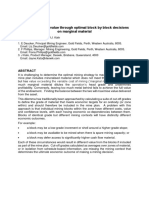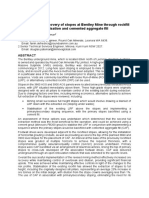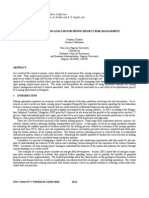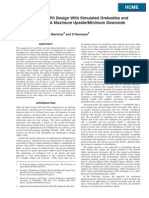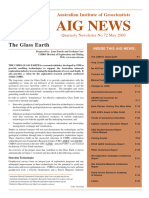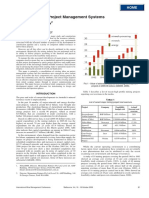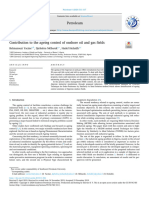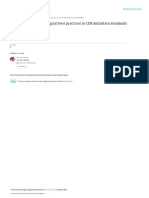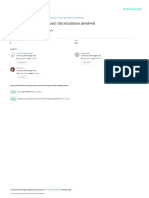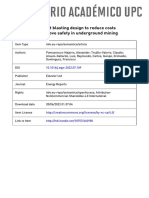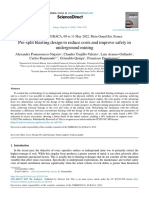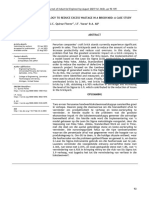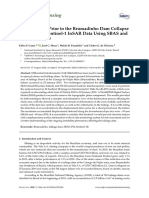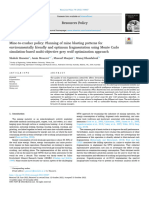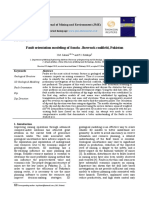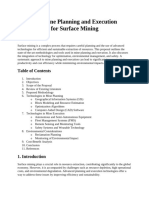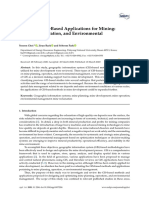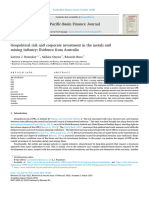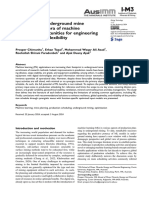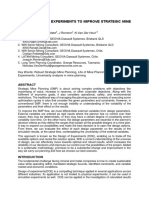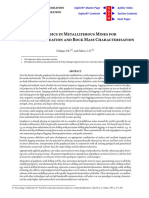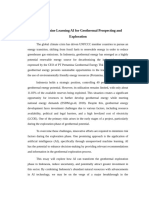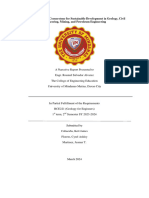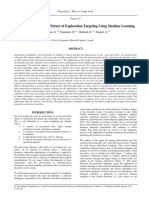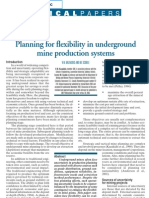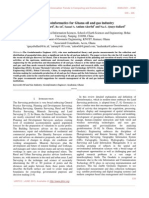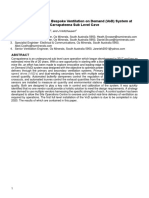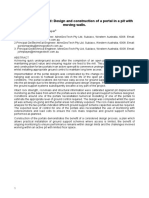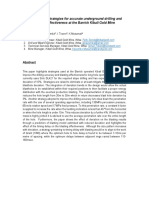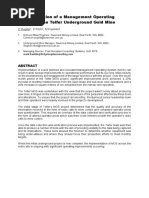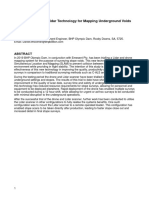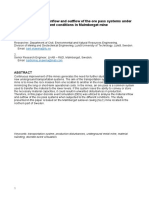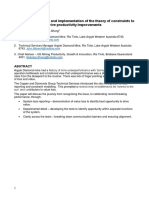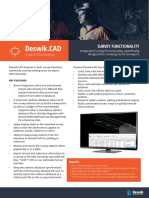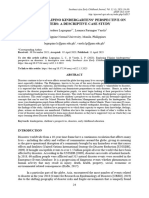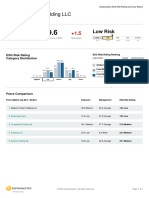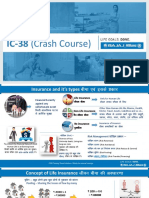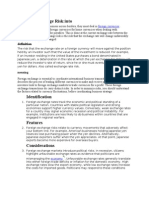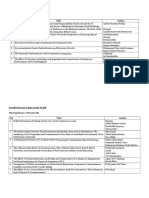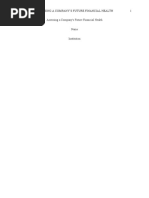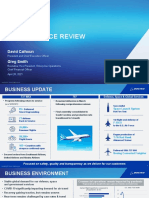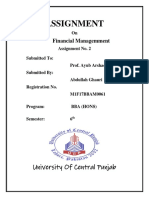Abstract 131 Integration of Geotechnical Data Into Block Models With Application To Geotechnical Hazards
Abstract 131 Integration of Geotechnical Data Into Block Models With Application To Geotechnical Hazards
Uploaded by
Stanley NehumbaCopyright:
Available Formats
Abstract 131 Integration of Geotechnical Data Into Block Models With Application To Geotechnical Hazards
Abstract 131 Integration of Geotechnical Data Into Block Models With Application To Geotechnical Hazards
Uploaded by
Stanley NehumbaOriginal Title
Copyright
Available Formats
Share this document
Did you find this document useful?
Is this content inappropriate?
Copyright:
Available Formats
Abstract 131 Integration of Geotechnical Data Into Block Models With Application To Geotechnical Hazards
Abstract 131 Integration of Geotechnical Data Into Block Models With Application To Geotechnical Hazards
Uploaded by
Stanley NehumbaCopyright:
Available Formats
INTEGRATION OF GEOTECHNICAL DATA INTO BLOCK MODELS WITH
APPLICATION TO GEOTECHNICAL HAZARDS
GAP Batista1, JM Seery2 JEF Ramires3 and JH Silva4
1.
Bastion Geotechical, Perth WA Australia 6005, G.Batista@bastiongeotech.com.au
2.
Bastion Geotechical, Perth WA Australia 6005. J.Seery@bastiongeotech.com.au
3.
AngloGold Ashanti, Crixás GO Brazil. JERamires@anglogoldashanti.com.br
4.
AngloGold Ashanti, Crixás GO Brazil. JHSilva@anglogoldashanti.com.br
Data Management, Rock Mass Model, Visualisation, Geotechnical Modelling, Geotechnical Hazard
ABSTRACT
Geotechnical engineering is the sector that manages one of the mine's greatest risks, rock
mass instability. The geotechnician's challenge is to develop an optimized design with a risk
management plan that meets the company's risk requirements and governmental safety standards.
The risks involve several factors, one of which is the geotechnical uncertainties that must be
minimized through proper investigation, so that the geotechnical conditions provide an environment
in which the project is more assertive and, therefore, will reduce the risk.
Projects must be additive, for that the database standards must be explicit. Data
management must follow a process flow, starting with the collection and ending with a data package
available during the analysis. To ensure data reliability and the development of a geotechnical model,
the process flow must follow a script based on data collection with an international standard,
obtaining data secured to ensure that it is not lost, acquisition of data reporting the accuracy of the
filling, data validation with appropriate interpretations and data package readily available with all
fields filled, updated and collected correctly.
Geotechnical models must contain data on structural, lithological, rock mass, stress and other
data following a standard that provides representativeness to the project. The model is expected to
provide an estimate of the likely conditions for the geotechnician can take the most assertive decision
to manage the risks involved.
With that knowledge, will be presented the best data management and geotechnical model
practices developed at Serra Grande Mine (MSG), located in central sector of Brazil, belonging to
AngloGold Ashanti (AGA), which has the largest gold production in Brazil. MSG was responsible for
25% of AGA Brazil's production in 2019 with gold extraction mainly from narrow ore bodies in the
sublevel mining method at a depth of 700 to 1000m.
This paper demonstrates how AGA's senior geotechnical managers establish a link in their
international operations ensuring standards. How MSG's geotechnical teams develop the work by
reducing the risks of the production plan. Finally, how the team synergistically manages the risks
involved in the project. The paper is a continuation of the papers already published by Hamman et
al. (2017), Seery et al. (2018), Hamman et al. (2019) that emphasizes the need to manage
geotechnical risk with current best mining practices.
You might also like
- Webinar Ppt-23rd AugustDocument120 pagesWebinar Ppt-23rd AugustPraveen B100% (5)
- Safety Management Plan TemplateDocument7 pagesSafety Management Plan TemplateYash KhuranaNo ratings yet
- Effective Mining Project Management SystemsDocument10 pagesEffective Mining Project Management Systemsjennifer_abols5419100% (1)
- Abstract 42 Maximising Asset Value Through Optimal Block by Block Decisions On Marginal MaterialDocument1 pageAbstract 42 Maximising Asset Value Through Optimal Block by Block Decisions On Marginal MaterialStanley NehumbaNo ratings yet
- Abstract 56 Optimising The Recovery of Stopes at Bentley Mine Through Rockfill Stabilisation and Cemented Aggregate FillDocument2 pagesAbstract 56 Optimising The Recovery of Stopes at Bentley Mine Through Rockfill Stabilisation and Cemented Aggregate FillStanley NehumbaNo ratings yet
- Managing Geotechnical Risk in Multi-Pit OperationsDocument12 pagesManaging Geotechnical Risk in Multi-Pit Operationsvictor elver guevara cerveraNo ratings yet
- Managing Geotechnical Risk in Multi-Pit OperationsDocument12 pagesManaging Geotechnical Risk in Multi-Pit OperationsCristian Segura BidermannNo ratings yet
- Abstract 64 Carrapateena Project To Date Geotechnical Risks and ManagementDocument1 pageAbstract 64 Carrapateena Project To Date Geotechnical Risks and ManagementStanley NehumbaNo ratings yet
- J Resourpol 2017 10 016-1Document18 pagesJ Resourpol 2017 10 016-1Laiss PizarroNo ratings yet
- AdaBoost Driven Multi Parameter Real Time Wa 2023 Engineering Applications oDocument13 pagesAdaBoost Driven Multi Parameter Real Time Wa 2023 Engineering Applications oirfanabbasNo ratings yet
- Using Simulation Analysis For Mining Project Risk ManagementDocument12 pagesUsing Simulation Analysis For Mining Project Risk ManagementGeorgi NedelchevNo ratings yet
- An Overview of New Integrated Geometallurgical ResearchDocument4 pagesAn Overview of New Integrated Geometallurgical ResearchDaniel Valdes JamettNo ratings yet
- 04 RobothamDocument10 pages04 RobothamLeon FouroneNo ratings yet
- Quantifying Risk in Geothermal Development - High Enthalpy and Low Enthalpy CasesDocument7 pagesQuantifying Risk in Geothermal Development - High Enthalpy and Low Enthalpy Casesmayalasan1No ratings yet
- Navarra2018 Modelos Geometalurgicos para El PlaneamientoDocument9 pagesNavarra2018 Modelos Geometalurgicos para El PlaneamientoYoselin CoronadoNo ratings yet
- Draw Rate Optimisation in Block Cave Production Scheduling Using Mathematical ProgrammingDocument14 pagesDraw Rate Optimisation in Block Cave Production Scheduling Using Mathematical Programmingsorion95No ratings yet
- 49 CastellonDocument8 pages49 CastellonEdmilson S. CastroNo ratings yet
- DimitrakopoulosDocument6 pagesDimitrakopoulosManolo Ericson GutiNo ratings yet
- Document 1 18Document18 pagesDocument 1 18Johana GarciaNo ratings yet
- Uncertainty-Based Production Scheduling in Open Pit Mining: R. Dimitrakopoulos and S. RamazanDocument7 pagesUncertainty-Based Production Scheduling in Open Pit Mining: R. Dimitrakopoulos and S. RamazanClaudio AballayNo ratings yet
- Stochastic Integer Programming For Optimising Long Term Production Schedules of Open Pit Mines Methods Application and Value of Stochastic SolutionsDocument7 pagesStochastic Integer Programming For Optimising Long Term Production Schedules of Open Pit Mines Methods Application and Value of Stochastic SolutionsmerhardtNo ratings yet
- Effective Mining Project Management Systems: D J Noort and C AdamsDocument10 pagesEffective Mining Project Management Systems: D J Noort and C AdamsmusharNo ratings yet
- Contribution To The Ageing Control of Onshore Oil and Gas FieldsDocument7 pagesContribution To The Ageing Control of Onshore Oil and Gas Fieldsadityamunthe93No ratings yet
- Geomet CIMDocument15 pagesGeomet CIMareftawana31No ratings yet
- 2022 - Marine Geohazards Exposed UncertaintiesDocument33 pages2022 - Marine Geohazards Exposed Uncertaintiesfaris nauvalNo ratings yet
- 10 1016j Egyr 2022 07 109Document19 pages10 1016j Egyr 2022 07 109Diego PalominoNo ratings yet
- 01 - Pre-Split Blasting Design To Reduce Costs and Improve Safety in Underground MiningDocument18 pages01 - Pre-Split Blasting Design To Reduce Costs and Improve Safety in Underground MiningLa LaNo ratings yet
- The Importance of Downhole Geophysical and Petrophysical Logging in Mining OperationsDocument3 pagesThe Importance of Downhole Geophysical and Petrophysical Logging in Mining OperationssandybattenNo ratings yet
- Process Safety Progress - 2022 - FRAM - Analyzing Human Factors and Complexities of Mining and O&G Process AccidentsDocument10 pagesProcess Safety Progress - 2022 - FRAM - Analyzing Human Factors and Complexities of Mining and O&G Process AccidentsWalber FreitasNo ratings yet
- Sigma MethodologyDocument14 pagesSigma Methodologyleylagale27No ratings yet
- Remotesensing 12 03664Document22 pagesRemotesensing 12 03664Salmangeos SalmangeosNo ratings yet
- 1 s2.0 S030142072200530X MainDocument15 pages1 s2.0 S030142072200530X Main20je0798No ratings yet
- Izhar Jiskani Fault Orientation Modeling of Sonda Jherruck Coalfield PakistanDocument9 pagesIzhar Jiskani Fault Orientation Modeling of Sonda Jherruck Coalfield PakistanAbdul Shakoor NuhrioNo ratings yet
- MNO NR Meridina Mining Bom Futuro Area Expansion Progress and JV UpdateDocument4 pagesMNO NR Meridina Mining Bom Futuro Area Expansion Progress and JV UpdatejoseanselmoNo ratings yet
- Application of Petrel Software in Reserve Estimation of Titas Gas Field (B &C Sand)Document1 pageApplication of Petrel Software in Reserve Estimation of Titas Gas Field (B &C Sand)showravNo ratings yet
- ProposalDocument4 pagesProposalzemengebremedhin670No ratings yet
- ISCSM 2018 KapageridisI - Etal.Document17 pagesISCSM 2018 KapageridisI - Etal.Sondang BerlianNo ratings yet
- Applied Sciences: Review of GIS-Based Applications For Mining: Planning, Operation, and Environmental ManagementDocument25 pagesApplied Sciences: Review of GIS-Based Applications For Mining: Planning, Operation, and Environmental Managementebrahim payamNo ratings yet
- MGPDocument29 pagesMGPWisdom NyamhosvaNo ratings yet
- A 3D Grid-Based Workflow For Fault Seal Capacity Estimation and Risking in ExplorationDocument5 pagesA 3D Grid-Based Workflow For Fault Seal Capacity Estimation and Risking in ExplorationAiwarikiaarNo ratings yet
- 80 Geological Geomechanical Modeling MarchesiDocument8 pages80 Geological Geomechanical Modeling MarchesiVinicius NavesNo ratings yet
- (Rumokoy Et Al., 2023) Geopolitical Risk and Corporate Investment in The Metals and Mining Industry - Evidence From AustraliaDocument17 pages(Rumokoy Et Al., 2023) Geopolitical Risk and Corporate Investment in The Metals and Mining Industry - Evidence From Australiaseptyonussy0No ratings yet
- SEG 2013 Part 1and 2 - Unconventional Plays Drive Geophysical, Computing TechnologyDocument19 pagesSEG 2013 Part 1and 2 - Unconventional Plays Drive Geophysical, Computing TechnologyFarzaneh SedighiNo ratings yet
- The Future of Underground Mine Planning in The Era of Machine Learning: Opportunities For Engineering Robustness and FlexibilityDocument17 pagesThe Future of Underground Mine Planning in The Era of Machine Learning: Opportunities For Engineering Robustness and FlexibilityRoohollahNo ratings yet
- PAPER - Using Design of Experiments To Improve Strategic Mine Planning - Ausimm - Life of Mine Conference 2021Document10 pagesPAPER - Using Design of Experiments To Improve Strategic Mine Planning - Ausimm - Life of Mine Conference 2021Cristian PobleteNo ratings yet
- Geography in Metalliferous Mines For Ore Body Delineation and Rock Mass CharacterisationDocument12 pagesGeography in Metalliferous Mines For Ore Body Delineation and Rock Mass CharacterisationkarinaNo ratings yet
- Goo Derrick (english version)Document4 pagesGoo Derrick (english version)Ikhra SashaaNo ratings yet
- Numerical Back-Analysis of Highwall Instability in An Open Pit: A Case StudyDocument16 pagesNumerical Back-Analysis of Highwall Instability in An Open Pit: A Case StudyAlcantara MarielaNo ratings yet
- Rock Mechanics A Paper Review in Gelogy For Engineers Group 3Document8 pagesRock Mechanics A Paper Review in Gelogy For Engineers Group 3p.canlas.539286No ratings yet
- Economic Viability of The Whole Tree Harvest Under Conditions of Uncertainty A Study in Southeastern BrazilDocument9 pagesEconomic Viability of The Whole Tree Harvest Under Conditions of Uncertainty A Study in Southeastern BrazilRoldão CarlosNo ratings yet
- Challenges and Proposed Action Plan For DGMS: Ministry of Labour & Employment Directorate General of Mines SafetyDocument4 pagesChallenges and Proposed Action Plan For DGMS: Ministry of Labour & Employment Directorate General of Mines Safetysrinibas mohapatraNo ratings yet
- Geomechanical Mine Design - Risk AssessmentDocument41 pagesGeomechanical Mine Design - Risk AssessmentTamrat MekonnenNo ratings yet
- Moving Forward From Traditional Optimization: Grade Uncertainty and Risk Effects in Open-Pit DesignDocument7 pagesMoving Forward From Traditional Optimization: Grade Uncertainty and Risk Effects in Open-Pit DesignJavier CerdaNo ratings yet
- 23 Targeting 2 BIG DataDocument5 pages23 Targeting 2 BIG DataRamadhani NdondeNo ratings yet
- Innovations Applied in Tailing Dams: ISSN: 2230-9926Document6 pagesInnovations Applied in Tailing Dams: ISSN: 2230-9926Neyda de La Caridad TapanesNo ratings yet
- Statistical Analysis of The Severity of Occupational Accidents in The Mining SectorDocument12 pagesStatistical Analysis of The Severity of Occupational Accidents in The Mining SectorGabriel Alencar Silva Almeida DantasNo ratings yet
- Kazakidis&scobleDocument6 pagesKazakidis&scobleCarlos Felipe Flores GuzmánNo ratings yet
- 0.03 PriscuDocument2 pages0.03 PriscuYondie MnikieNo ratings yet
- Role of Geoinformatics For Ghana Oil and Gas IndustryDocument8 pagesRole of Geoinformatics For Ghana Oil and Gas Industryandika12105100% (1)
- BesterDocument16 pagesBesterRonan CayoNo ratings yet
- NR 39 17 NR Saramacca November 2017 Drill Updates enDocument7 pagesNR 39 17 NR Saramacca November 2017 Drill Updates enSuriname MirrorNo ratings yet
- Perspectives to CO2 Geological Storage and Greenhouse Gas Negative Emissions in South-Southeastern Brazil: Paraná and Santos Sedimentary BasinsFrom EverandPerspectives to CO2 Geological Storage and Greenhouse Gas Negative Emissions in South-Southeastern Brazil: Paraná and Santos Sedimentary BasinsNo ratings yet
- Abstract 117 The Application of A Bespoke Ventilation On Demand VoD System at Carrapateena Sub Level CaveDocument1 pageAbstract 117 The Application of A Bespoke Ventilation On Demand VoD System at Carrapateena Sub Level CaveStanley NehumbaNo ratings yet
- Abstract 57 Getting Underground Design and Construction of A Portal in A Pit With Moving WallsDocument1 pageAbstract 57 Getting Underground Design and Construction of A Portal in A Pit With Moving WallsStanley NehumbaNo ratings yet
- Abstract 68 A Methodology For Assessing Stope Design Modifying Factors For The Olympic Dam MineDocument1 pageAbstract 68 A Methodology For Assessing Stope Design Modifying Factors For The Olympic Dam MineStanley NehumbaNo ratings yet
- Abstract 82 On The Flipside Why Cost Cutting Is Out Revenue Maximization Is in and Value Is Always KingDocument1 pageAbstract 82 On The Flipside Why Cost Cutting Is Out Revenue Maximization Is in and Value Is Always KingStanley NehumbaNo ratings yet
- Abstract 104 Open Stope Design Beyond The Stability GraphDocument1 pageAbstract 104 Open Stope Design Beyond The Stability GraphStanley NehumbaNo ratings yet
- Abstract 31 Development and Permitting of An Underground Mine at Cowal Gold OperationsDocument1 pageAbstract 31 Development and Permitting of An Underground Mine at Cowal Gold OperationsStanley NehumbaNo ratings yet
- Abstract 24 Improvement Strategies For Accurate Underground Drilling and Blasting Effectiveness at The Barrick Kibali Gold MineDocument1 pageAbstract 24 Improvement Strategies For Accurate Underground Drilling and Blasting Effectiveness at The Barrick Kibali Gold MineStanley NehumbaNo ratings yet
- Abstract 16 Implementation of A Management Operating System at The Telfer Underground Gold MineDocument1 pageAbstract 16 Implementation of A Management Operating System at The Telfer Underground Gold MineStanley NehumbaNo ratings yet
- Abstract 60 Implementation of A High Energy Dissipation Ground Support SchemeDocument2 pagesAbstract 60 Implementation of A High Energy Dissipation Ground Support SchemeStanley NehumbaNo ratings yet
- Abstract 80 Use of Drone and Lidar Technology For Mapping Underground VoidsDocument1 pageAbstract 80 Use of Drone and Lidar Technology For Mapping Underground VoidsStanley NehumbaNo ratings yet
- Abstract 30 Application of Steel Bollards For Managing The Hazards Associated With Open Stopes Waihi Underground OperationsDocument1 pageAbstract 30 Application of Steel Bollards For Managing The Hazards Associated With Open Stopes Waihi Underground OperationsStanley NehumbaNo ratings yet
- Abstract 19 Carrapateena Crows Foot Level Layout - Safety in Design To Support Sub Level Cave Production Efficiency and AutomationDocument1 pageAbstract 19 Carrapateena Crows Foot Level Layout - Safety in Design To Support Sub Level Cave Production Efficiency and AutomationStanley NehumbaNo ratings yet
- Abstract 85 Analysing Material Inflow and Outflow of The Ore Pass Systems Under Different Conditions in Malmberget MineDocument1 pageAbstract 85 Analysing Material Inflow and Outflow of The Ore Pass Systems Under Different Conditions in Malmberget MineStanley NehumbaNo ratings yet
- Abstract 88 Argyle Loss Reporting and Implementation of The Theory of Constraints To Drive Productivity ImprovementsDocument1 pageAbstract 88 Argyle Loss Reporting and Implementation of The Theory of Constraints To Drive Productivity ImprovementsStanley NehumbaNo ratings yet
- Deswik - CAD Survey Functionality Flyer PDFDocument1 pageDeswik - CAD Survey Functionality Flyer PDFStanley NehumbaNo ratings yet
- Disaster Preparedness Case Study - GuroDocument16 pagesDisaster Preparedness Case Study - GuroSwag MasterNo ratings yet
- Majid Al Futtaim Holding LLC RiskRatingsSummaryReport 2021Document7 pagesMajid Al Futtaim Holding LLC RiskRatingsSummaryReport 2021anandpandatNo ratings yet
- Project Report: "Study On Portfolio Management Services Strategies and Investors Awareness and Prefrence For It"Document49 pagesProject Report: "Study On Portfolio Management Services Strategies and Investors Awareness and Prefrence For It"Nitesh BaglaNo ratings yet
- IC-38 Crash CourseDocument18 pagesIC-38 Crash CourseÅdârsh DûßêyNo ratings yet
- Entrepreneurship Development - Code-307, BBA (Gen.) - Sem. VDocument120 pagesEntrepreneurship Development - Code-307, BBA (Gen.) - Sem. VVikash kumarNo ratings yet
- Mind Matters Lessons From Past Crises For Child and Adolescent Mental Health During COVID 19Document70 pagesMind Matters Lessons From Past Crises For Child and Adolescent Mental Health During COVID 19sofiabloemNo ratings yet
- Switching Behavior in The Adoption of A Land Information System in China A Perspective of The Push-Pull-Mooring FrameworkDocument12 pagesSwitching Behavior in The Adoption of A Land Information System in China A Perspective of The Push-Pull-Mooring FrameworkAnjaya Tirta100% (1)
- Effective Healthcare Practice Using Math Assignment-1 BTECDocument18 pagesEffective Healthcare Practice Using Math Assignment-1 BTECsesaeedhaniyah.dNo ratings yet
- 2008 FullDocument68 pages2008 FullpensiontalkNo ratings yet
- 1foreign Exchange RiskDocument11 pages1foreign Exchange Riskpriya_desaiNo ratings yet
- CIDAM in 1st Quarter DRR 2023Document3 pagesCIDAM in 1st Quarter DRR 2023mark jay legoNo ratings yet
- ConferDocument16 pagesConferOdhenk KhanNo ratings yet
- Running Head: Assessing A Company'S Future Financial Health 1Document5 pagesRunning Head: Assessing A Company'S Future Financial Health 1DonaldNo ratings yet
- A Study On The Awareness of Importance in Having Life Insurance Policy Among UiTM Seremban 3 StudentDocument5 pagesA Study On The Awareness of Importance in Having Life Insurance Policy Among UiTM Seremban 3 StudentArjannah HashimNo ratings yet
- The First Scottish Conference For: Postgraduate Researchers of The Built and Natural EnvironmentDocument731 pagesThe First Scottish Conference For: Postgraduate Researchers of The Built and Natural EnvironmentFranciany Vega RodeloNo ratings yet
- IOR Operational Loss EventsDocument22 pagesIOR Operational Loss EventsAbhishek YadavNo ratings yet
- Medication Errors: Technical Series On Safer Primary CareDocument31 pagesMedication Errors: Technical Series On Safer Primary CaredidikNo ratings yet
- APF 2023 FallDocument61 pagesAPF 2023 FallMinh Nguyễn AnhNo ratings yet
- CVSyed HassanDocument4 pagesCVSyed HassanAliya HussainNo ratings yet
- Introduksi Analisa Kerusakan (Failure Analyses)Document18 pagesIntroduksi Analisa Kerusakan (Failure Analyses)yanuarNo ratings yet
- Bank Credit Analysis University Study MaterialDocument116 pagesBank Credit Analysis University Study MaterialSekar Murugan100% (2)
- Performance Review: First-Quarter 2021Document14 pagesPerformance Review: First-Quarter 2021ZerohedgeNo ratings yet
- De Beers ReportDocument90 pagesDe Beers Reportavinram100% (1)
- Assignment: University of Central PunjabDocument12 pagesAssignment: University of Central PunjabAbdullah ghauriNo ratings yet
- Chapter 6 - Project Risk and CommunicationDocument31 pagesChapter 6 - Project Risk and CommunicationZsarina Pink DavidonNo ratings yet
- RD 2024 Leadership Vision UpdatedDocument18 pagesRD 2024 Leadership Vision UpdatedMarco MirandaNo ratings yet
- Kotak Securities Limited FY18Document81 pagesKotak Securities Limited FY18Arpita Sen BhattacharyaNo ratings yet
- Drone For Mining SurveyDocument8 pagesDrone For Mining SurveyRendy Fahlevi100% (1)



